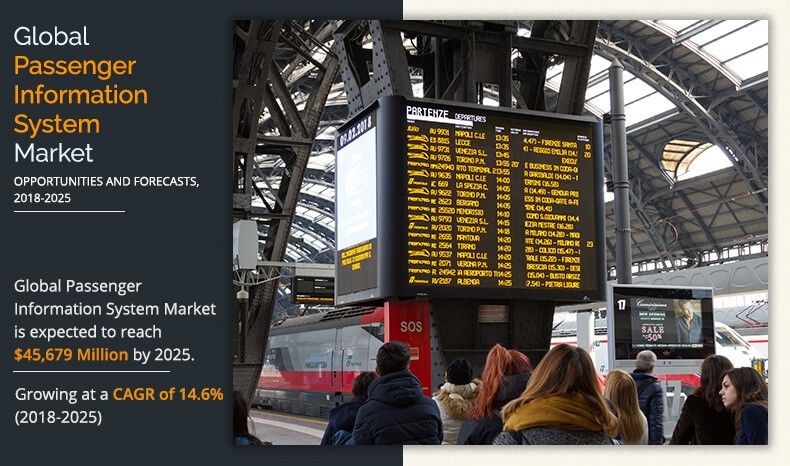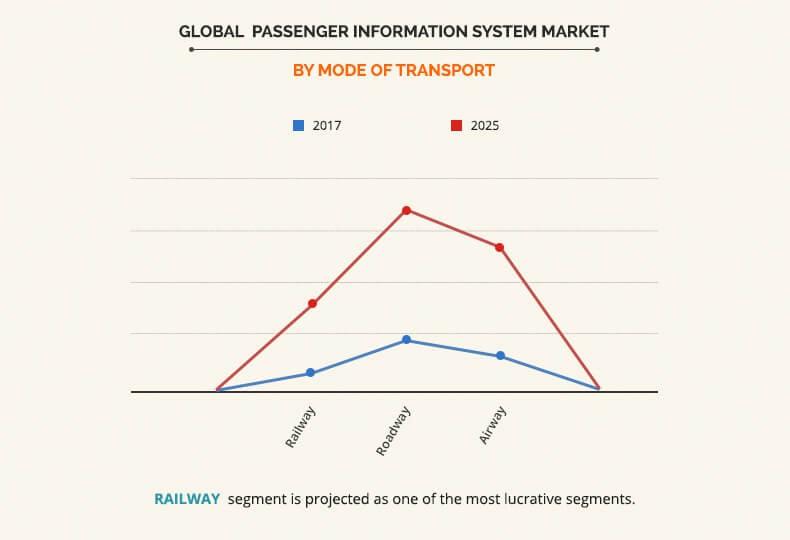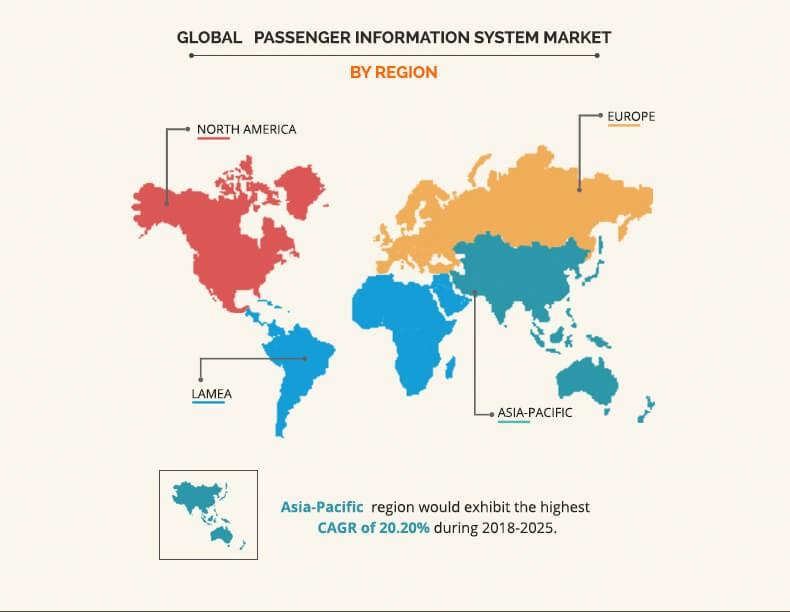Passenger Information System Market Statistics, 2025
Passenger information system market acts as the communication link between a transit agency and passengers. It enables to deliver information related to real-time vehicle location & status updates, schedule of journey, and timely announcements. Along with these functionalities, it focuses on improvement of the transit experience for passengers by entertaining the passengers through infotainment systems. Moreover, these systems can be deployed on platform and inside the transportation vehicle such as bus/train/flight. Passenger information system market was valued at $13,703 million in 2016, and is expected to hit at $45,679 million by 2025, growing at a CAGR of 14.60% from 2018 to 2025.
Rise in demand for transit agencies to deliver reliable and accurate real-time transit information to passengers drives the growth of the passenger information system market. Furthermore, advancements in the telecommunication sector to enable faster data transfer capabilities, surge in IoT adoption in transportation sector, and increase in demand for intelligent transportation systems are the major factors responsible for the growth of the market. In addition, rise in adoption of cloud and big data technologies is expected to provide lucrative opportunities for the market growth. However, high cost associated with implementation and management of these system impedes the growth of this market.
The roadway segment led the market in 2016, and is expected to dominate in the near future. However, the railway segment is expected to grow at a significant pace during the forecast period. Furthermore, Asia-Pacific is expected to show high growth rate, as it experiences the highest demand for passenger information system.
The report focuses on the growth prospects and restraints of the market based on the analysis of regional trends. The study provides Porters Five Forces analysis of the industry to understand the impact of various factors such as bargaining power of suppliers, competitive intensity of competitors, threat of new entrants, threat of substitutes, and bargaining power of buyers on the growth of the market.
Segment Review
The global passenger information system market is segmented based on component, solutions, mode of transportation, and geography. By component, the market is divided into hardware, software, and services. On the basis of solution, it is categorized into information display system, announcement systems, infotainment systems, passenger information mobile applications, and emergency communication systems. Depending on mode of transportation, it is fragmented into airway, railway, and roadway. Geographically, it is analyzed across North America, Europe, Asia-Pacific, and LAMEA.
The global passenger information system market is dominated by the key players such as Alstom, Cubic Corporation, Hitachi, Ltd., Indra, Mitsubishi Electric Corporation, Siemens AG, Singapore Technologies Electronics Limited, Teleste Corporation, Thales, and Toshiba Corporation.
Top Impacting Factors
Increase in demand by passengers for accurate real-time transit information, advancements in telecommunication sector to offer faster data transfer, and rise in adoption of cloud & big data technologies among transportation sector drive the demand for PIS market. However, dearth of advanced infrastructure facilities to install passenger information system and high cost associated with implementation of these systems hamper the market growth.
Increased Adoption of Smartphones
Mobile application-based passenger information systems are rapidly gaining traction due to increased penetration of smartphones. Furthermore, around 5.3 billion unique mobile subscribers were registered in June 2018 with the Y-o-Y growth of around 3.5%. In addition, transit agencies are focusing on mobile applications of PIS to attract the passengers and provide them with quick and reliable real-time information through smartphone channel. Moreover, emergence of multi-modal transit app for public transport is opportunistic for the growth of the market.
Rise in Adoption of Cloud & Big Data Technologies
Cloud computing is adopted for the automation of different modes of transportation, especially railways. The passenger information system utilizes cloud computing technology to track the position of buses in the area and calculate the arrival time to be displayed on the real-time information system at the bus stop. Cloud technology and data analytics solutions aid in providing high efficiency in allocating resources and monitoring the passenger population in a cost-effective manner.
Dearth of Advanced Infrastructure for Installing Passenger Information System
The lack of advanced and technologically updated system infrastructure is hindering the growth of passenger information system market. In some underdeveloped regions of Africa and Asia, the conditions of roads and transportation facilities are still in the development stage. In addition, lack of awareness, usage of legacy systems, and poor internet connectivity in the underdeveloped nations restrict the deployment and usage of passenger information systems.
High Cost of Implementation
Passenger information systems have complex operational procedures due to integration of associated additional components. This adds to the overall cost for the information system, owing to the complications associated with installation and cost of hiring experienced and skilled professionals of PIS market. These systems require regular maintenance checks to ensure the functionality and reliability of the system, which results in extra maintenance cost that impedes the growth of the market.
Key Benefits
- This study includes the analytical depiction of the global passenger information system market along with current trends and future estimations to determine the imminent investment pockets.
- The report presents information related to key drivers, restraints, and opportunities.
- The current market is quantitatively analyzed from 2016 to 2025 to highlight the financial competency of the industry.
- Porters Five Forces analysis illustrates the potency of buyers & suppliers in the global passenger information system industry.
Passenger Information System Market Report Highlights
| Aspects | Details |
| By Component |
|
| By Solution |
|
| By Mode Of Transportation |
|
| By Region |
|
| Key Market Players | TELESTE CORPORATION, INDRA SISTEMAS SA, HITACHI, LTD., SIEMENS AG, THALES GROUP, SINGAPORE TECHNOLOGIES ELECTRONICS LIMITED, TOSHIBA CORPORATION, ALSTOM, MITSUBISHI ELECTRIC CORPORATION, CUBIC CORPORATION |
Analyst Review
Passenger information system is a set of IT systems and hardware components meant to provide real-time information to passengers on the state and nature of a transport service through voice, visual, and media devices. In addition, it offers entertainment & news services and information on estimated arrival & departure schedule, which result into enhanced experience throughout the journey.
Demand for passenger information system has increased over a period of time, due to rise in air traffic, increased penetration of IoT solutions in the transportation sector, upsurge in demand of passengers to have real-time transit information and surge in adoption of intelligent transportation systems. Furthermore, rise in demand for all the information related to passenger journey right from journey planner to fluctuations in estimated departure timing is expected to be opportunistic for the passenger information system market. Furthermore, rise in awareness among transit agencies about offering enhanced traveling experience to passengers is anticipated to boost the growth of the market during the forecast period.
Moreover, extensive adoption of cloud technology and increased penetration of mobile applications are anticipated to create lucrative opportunities for the passenger information system market during the forecast period. Leading vendors operating in the market have introduced advanced mobile applications supporting android and iOS platforms for passenger information system.
Some of the key players o profiled in the report include Alstom, Cubic Corporation, Hitachi, Ltd., Indra, Mitsubishi Electric Corporation, Siemens AG, Singapore Technologies Electronics Limited, Teleste Corporation, Thales, and Toshiba Corporation. These players have adopted various growth strategies to enhance their product portfolio and market penetration. They launch new products to increase their customer base and to cater the increasing demands of the customers. For instance, Papercast launched solar powered e-paper displays, which are sunlight readable and weather- & vandal-proof with wireless connectivity.
Loading Table Of Content...





